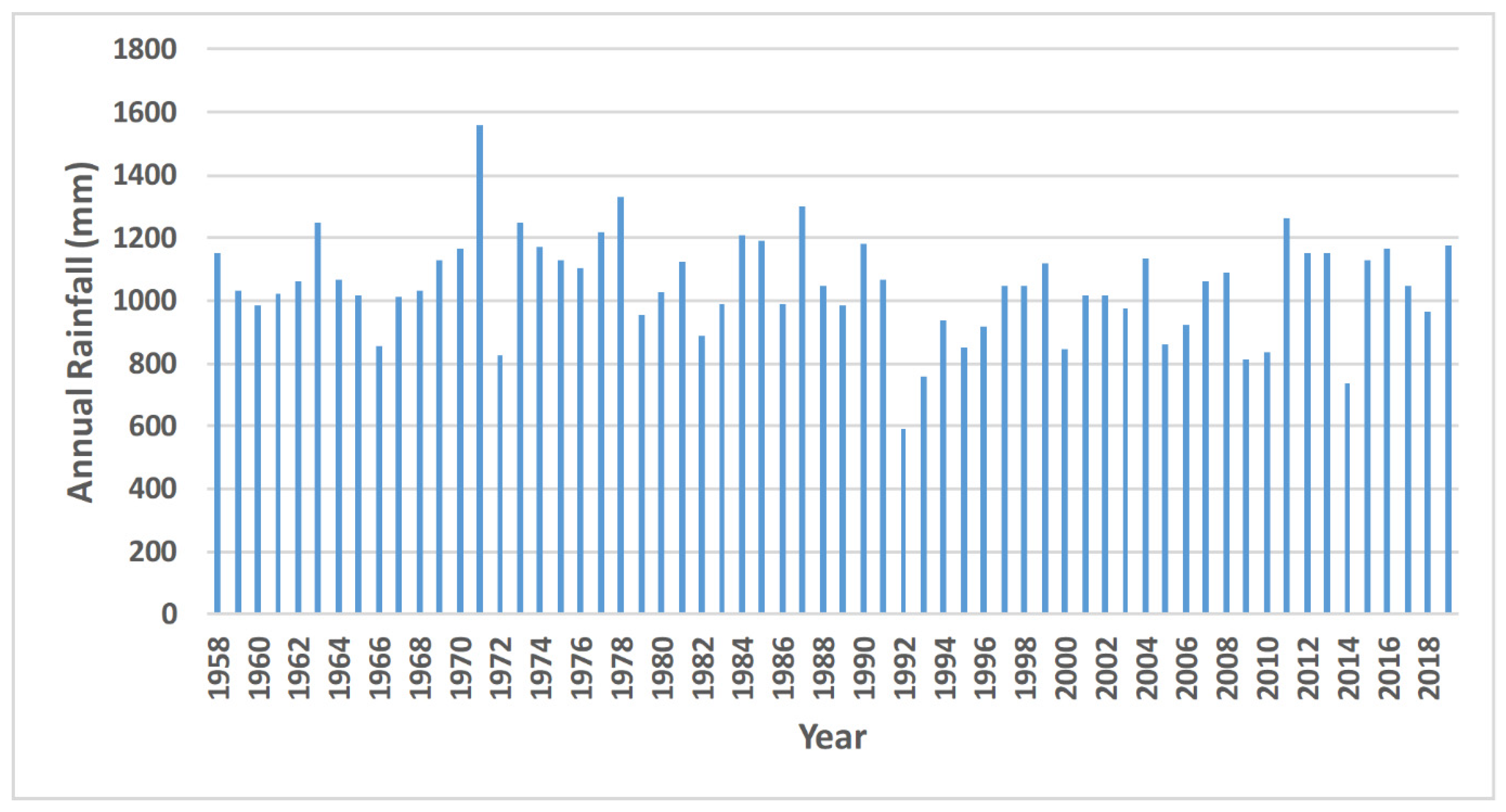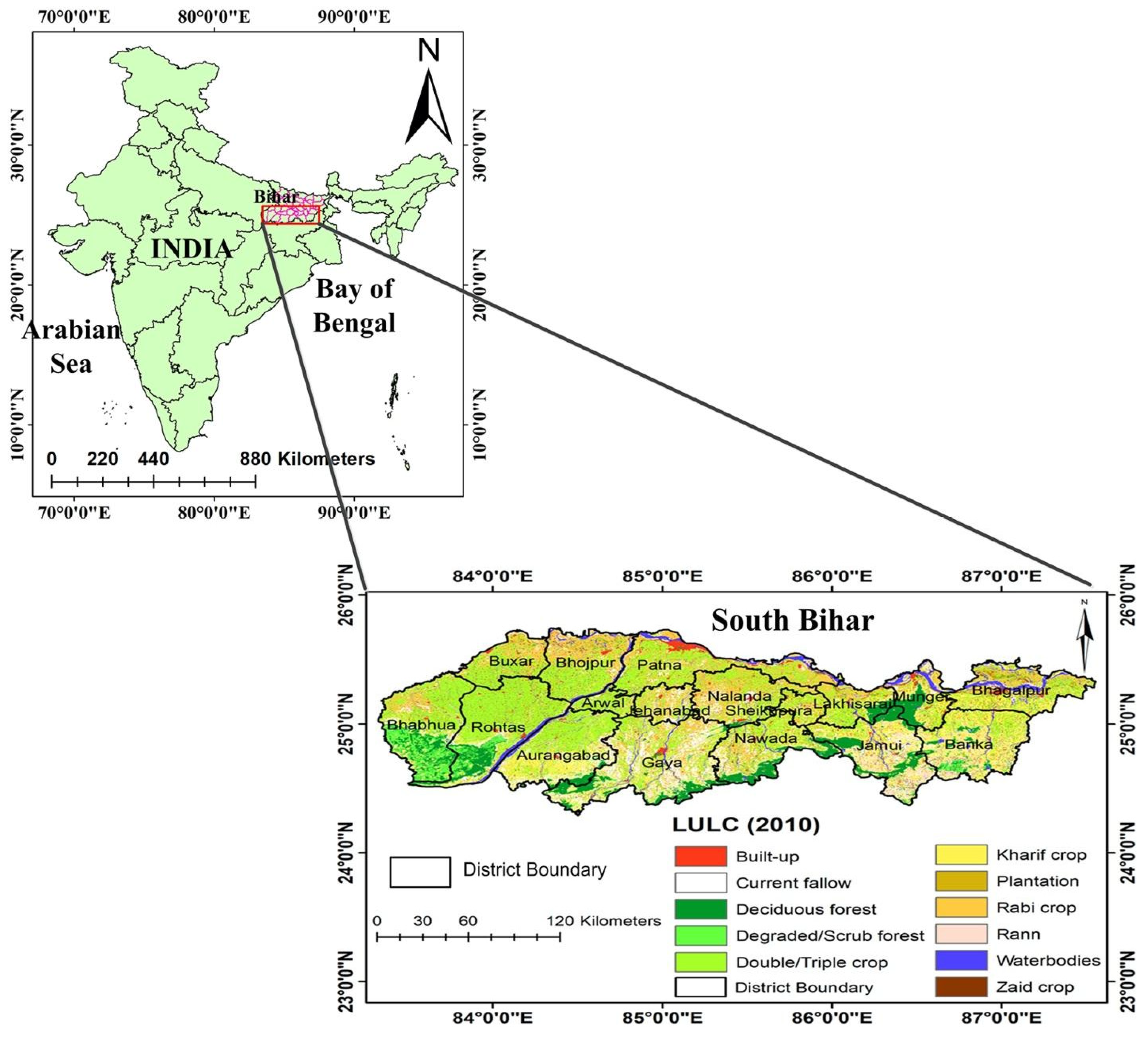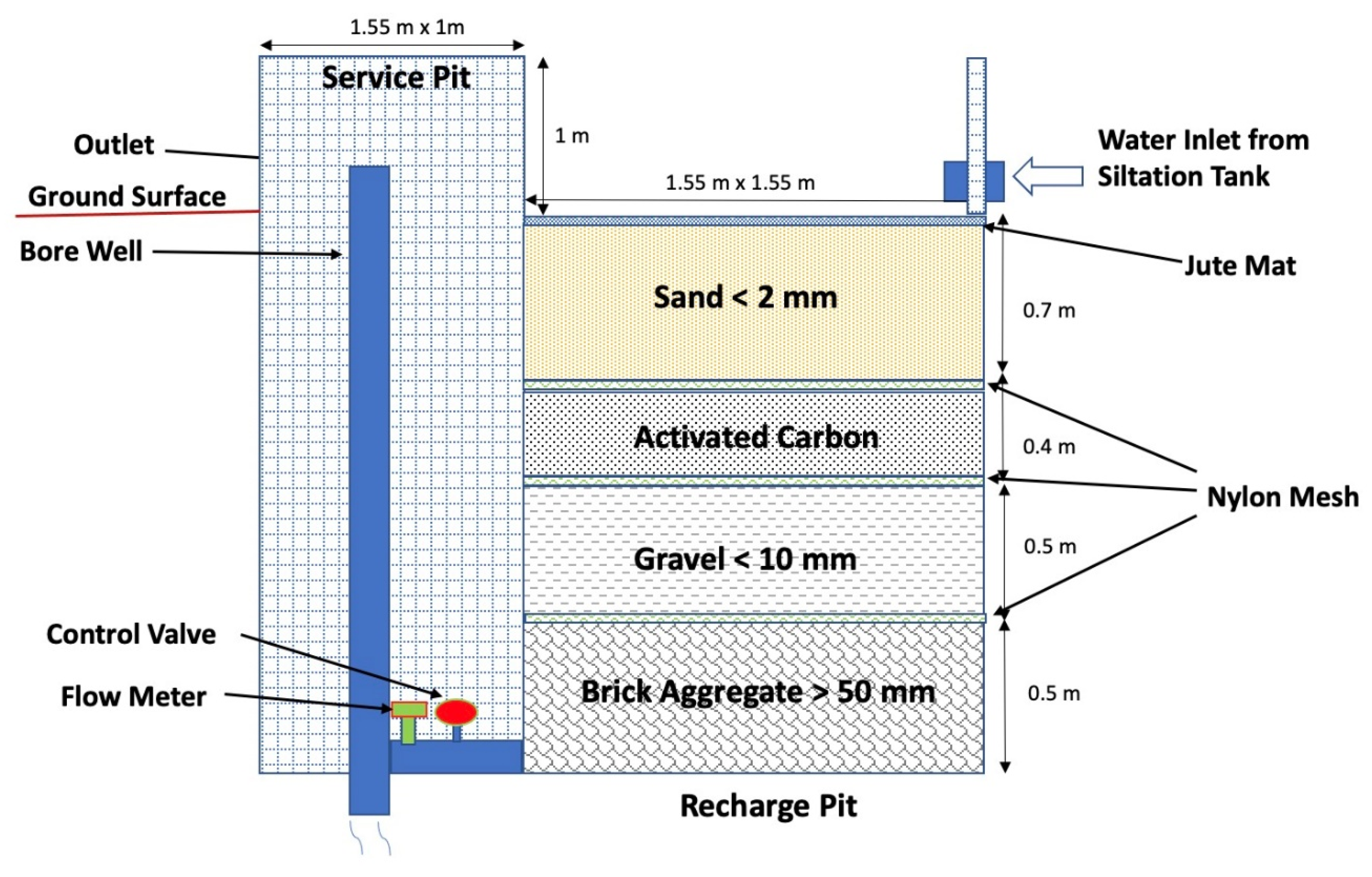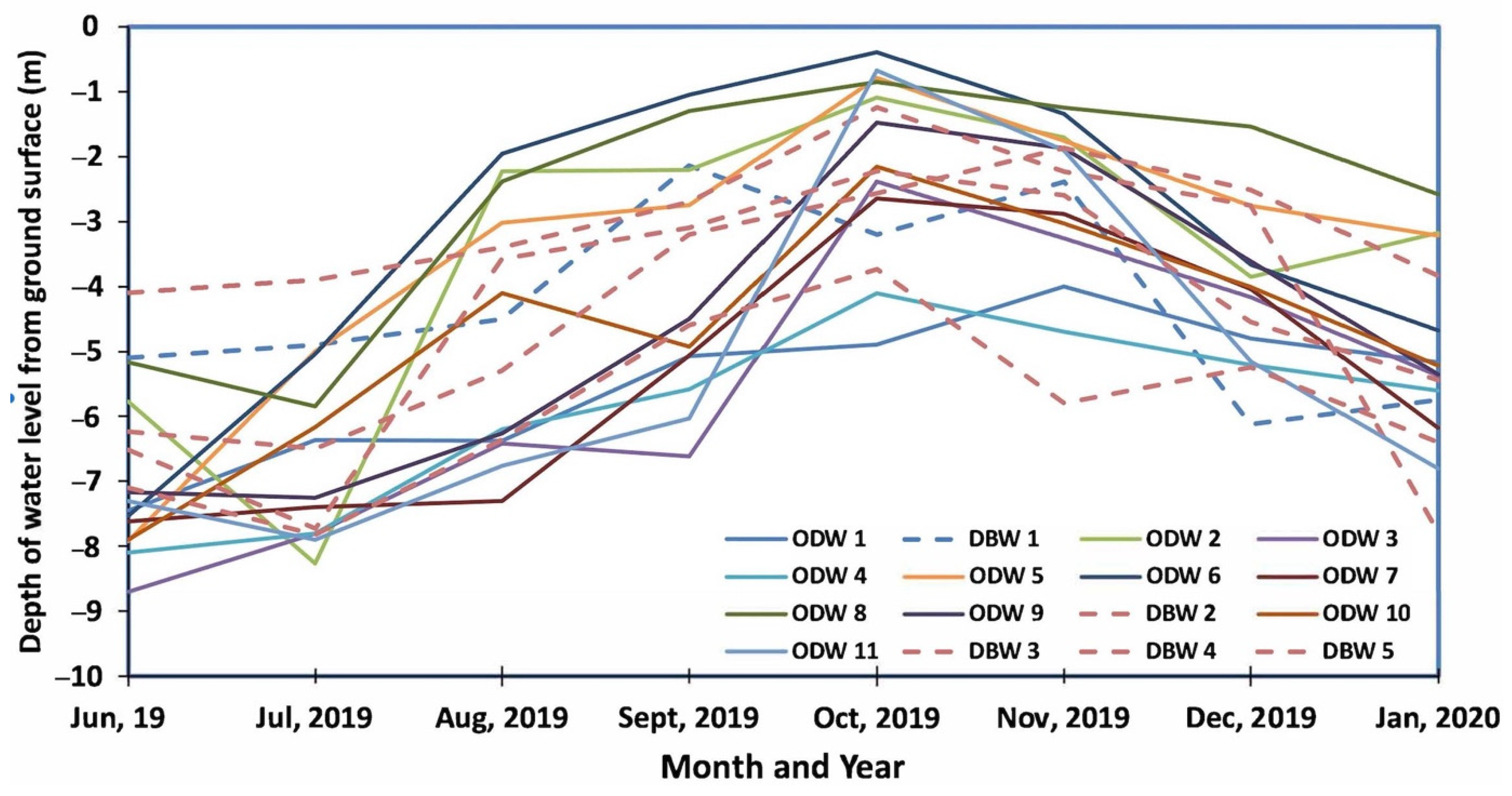1. Introduction
Climate change is altering India’s hydrologic regimes, resulting in changed duration and frequency of severe floods and droughts [
1]. The state of Bihar in India is especially vulnerable to floods and droughts, often leading to significant disruption in agriculture—the mainstay of people’s life and property [
2,
3,
4,
5,
6]. Among the
rabi crops (sown in October/November and harvested in February/March in India), wheat is particularly at risk due to the unavailability of reliable sources of irrigation and depletion of groundwater, which has emerged as a primary source of irrigation in recent years [
7,
8]. Ensuring reliable irrigation is one of the major challenges for sustainable agriculture in South Bihar.
Several options, mainly variants of managed aquifer recharge (MAR) techniques, are being promoted in some parts of India and across the globe to enhance depleted groundwater reserve through recharge of aquifers using excess surface water in the rainy season [
9,
10]. Aquifer storage and recovery (ASR) is a well-known sub-surface technique to replenish depleted aquifers [
11,
12]. However, the success of ASR is contingent upon the selection of appropriate sites based on the local hydrogeological, hydrometeorological, and socio-economical environments [
13].
This paper explores the potential of scaling up ASR in the marginal alluvial plains of South Bihar based on a pilot initiative conducted in two villages of Rajgir block of Nalanda district in Bihar, India. The pilot is distinctive for three reasons: first, it emphasises sustainability by adopting a multi-disciplinary approach to site selection; second, it integrates water quality and clogging concerns in the technical and operational design itself; and third, it is among the first such initiatives in the conventionally water-rich areas of eastern India. The regional context is significant for primarily two reasons. First, overexploitation of groundwater from the deeper aquifers in eastern India is less known since the focus is mainly on the seasonal recharge of the upper aquifers. Therefore, using deeper aquifers for storage and recovery has the same potential as the better-known experiments with ASR in coastal saline aquifers [
14] and arid western India [
9,
10,
15]. Second, widespread private investments in deep borewells, despite a meagre success rate, suggest that an entrepreneurial lead farmer-owned model is more likely to succeed as a sustainable and scalable option.
2. Drought, Depleting Groundwater, and Agrarian Distress in South Bihar
Bihar is one of the most populous states in India, ranked third after Uttar Pradesh and Maharashtra. Approximately 89% of Bihar’s population lives in the villages [
16]. Bihar’s per capita GDP in 2018–2019 was USD 419 only, which was the lowest among the Indian states and way below the national average of USD 1270 in 2012 prices [
17]. Geographically, the state is separated into two parts (North and South Bihar) by the river Ganges, whose southern tributaries such as the Karamnasa, Durgawati, Sone, Punpun, Falgu, Harohar, Badua, and Chandan rivers are seasonal, originating in the Chhotanagpur plateau, unlike the perennial Himalayan rivers in the North. Rainfall in South Bihar (average 898 mm) is significantly low as compared to North Bihar (average 1206 mm) and concentrated during the monsoon season (June–September months) [
18]. The annual rainfall variability is also wide, recording a maximum of 1560 mm in 1971 and a minimum of 594 mm in 1992 (
Figure 1). South Bihar is generally considered a drought-prone region with an acute water stress during summers [
19]; it adversely affects the winter (
rabi) crop, which is critically dependent on irrigation, primarily from groundwater sources (
Figure 2). The
Figure 2 also indicates the lack of presence of surface waterbodies as well as most of the areas are producing double crop with high dependance on groundwater irrigation. With an estimated 900,000 shallow and 1700 deep tube wells constructed in the state [
20], groundwater has been the mainstay of irrigation in Bihar for quite some time [
7]. These numbers are estimated to have proliferated in recent years, accounting for significant farm investments, and often indebtedness. Moreover, while a large farmer invests an average of USD 455 on the installation of tube wells, a marginal farmer also invests USD 268, according to a study in Nalanda district of South Bihar, India [
21].
As the need for more significant investments increases with increasing depth of tube-wells and a growing risk of failures due to limited aquifer capacity in the marginal alluvial plains, small, and marginal farmers become more vulnerable. Around 83% of land holdings are categorised as marginal (size less than 1 hectare) and 9% as small (size between 1–2 hectare) in Bihar [
22]. These small and marginal farmers face severe socio-economic challenges to sustain their livelihoods in the region’s rapidly changing agrarian economy [
23]. Environmental stresses, including climatic variability and depleting groundwater sources, are further exacerbating their situation. Sustainable intensification of agriculture is not possible until irrigation sources are secured [
24], especially when farming has increasingly been dependent on groundwater in the state [
7].
3. Piloting ASR Initiatives in South Bihar
ASR techniques have been used globally for over half a century to augment groundwater reserves in Israel [
14], recycle treated water in Florida [
25], and create freshwater reserves in the saline aquifers of South Australia [
26]. ASR can also be used for environmental benefits such as recharge of overexploited zones, control the deterioration of groundwater quality, and prevent the destruction of the aquifer and land subsidence [
15,
27]. Although relatively new, ASR projects have proliferated in several locations across India in response to needs of agriculture and domestic water supplies in overexploited regions of north Gujarat and southern Rajasthan [
9,
28], saline coastal regions of Tamil Nadu [
29], arid zone of eastern India [
30,
31], and undergoing research work in South Bihar, India [
13].
While various types of managed aquifer recharge (MAR) techniques such as
ahar-pynes (a traditional water harvesting structure reported from South Bihar), farm ponds, and check-dams are common in South Bihar, ASR is a novel technique in the region that actively uses aquifers to store excess rainwater from the wet season for irrigation and for other uses during dry months. ASR technique was piloted in two villages (Nekpur and Meyar) of Rajgir Block in Nalanda district of South Bihar during 2019–2020 as shown in
Figure 3. The study area is known for chronic water shortage during summers, categorised as a semi-critical area by the Central Ground Water Board of India due to over-exploitation of groundwater. For these locations, the drinking water needs are primarily met from groundwater sources, while irrigation needs are fulfilled by seasonal rains mostly during June–September and by groundwater for the rest of the year. Tentative sites were identified based on the available hydrometeorological and hydrogeological data, while specific sites were selected based on socio-economic field-data analysis [
13,
32].
The question of site selection for recharge pits in the study area is related to the possibility of effective storage and recovery as well as the feasibility of an efficient mechanism for implementation and use. The water availability, aquifer storage potential, and land suitability were assessed based on different variables, for which the data was collected from secondary and primary sources. It was found that ASR may not work everywhere after meeting the scientific guidelines only but it should also be socially acceptable and economically feasible. Among the different variables, the geospatial parameters (rainfall, runoff generation, surface elevation, land-use pattern, water table depth) helped in identification of the suitable watershed boundaries and low-lying areas for excess surface water supplies, i.e., individual villages in the current study. Later, the socio-economic parameters (local knowledge on surface water bodies, aquifer, and recharge potential, land holding size, willingness to participate) provided the information about the individual ASR locations, i.e., farmers who are willing to provide their land for the proposed ASR installations. Finally, the combinations of physico-chemical (water quality, soil characteristics, and aquifer characteristics) and socio-economic parameters confirmed the exact depth of recharge zones, possible impact of water quality change due to recharge, proposed volume of recharge, need for maintenance of recharge pit to avoid clogging, and overall implementation and functioning guidelines of ASR system. It is evident that the hybrid but integrated model for site selection covering both scientific and socio-economic data collected from secondary and primary sources will enable the project implementers for ASR to be more successful.
Appropriate filtration pits are essential to prevent groundwater pollution due to the injection of contaminated water and possible clogging of the recharge system [
27]. The design shared with the stakeholder farmers for installing ASR systems at the selected sites included both (i) filtration pits and (ii) injection well (
Figure 4). In the recharge pit, the first layer consists of coarse sand for removing the mixed clay or other dissolved matter, the second layer consists of activated charcoal for reducing the dissolved salt, and similar compounds, while the third and fourth layers consist of gravel and broken puffed bricks, respectively, to allow smooth injection of recharged water as shown in
Figure 4. As a precautionary measure, a control valve is attached for the emergency closure of recharge water in the event of contamination or repair of recharge pits. A flow meter was installed at the entry point of the borewell for estimation of total recharge volume for proper groundwater balance estimation of the region (
Figure 4).
Before installing ASR systems in the piloted villages of Nekpur and Meyar, 137 wells (71 dug wells, 19 shallow borewells, and 47 deep borewells) were monitored during 2019–2020 to understand the seasonal water level variations. Most of the dug-wells and shallow borewells of the region dried up during the winters, seriously affecting the rabi crop and even domestic water supplies. This is clearly evident from the seasonal variation of groundwater level in one of the piloted village in this study (
Figure 5). The figure indicates a sharp decrease in groundwater level measured in a number of open dug wells and deep borewells. For the selected year of this study, the groundwater level is the nearest to the ground surface in the month of October due to late rainfall in September 2019 in this region (
Figure 5). The villagers devised different coping strategies to tackle this seasonal water stress. A few economically better-off and resourceful farmers opted for deep borewells, whereas others had to rely on tanker water supplies and other available sources in the neighborhood. The majority of the families (average family size of four) in these two villages are marginal/small farmers (landholding between 0.2 to 2 hectare only) with monthly family incomes in the range of USD 30–300, which is much below Bihar’s per capita income of USD 419 in the year 2018–2019. In addition, the deep borewells are generally a perennial water source, but they are expensive; moreover, only about one in four deep borewells are productive in Nekpur village.
Seasonal water availability also determines the cropping pattern in South Bihar, since agriculture in the region is predominantly rainfed. Farmers in the low-lying areas can cultivate pulses (such as gram, green gram, lentil, mustard) during rabi season only after draining the excess water from the land. On the other hand, farmers on higher reaches can cultivate two crops, usually paddy during kharif (June–October) and wheat, onion, or other vegetables during rabi (October–March). Installing ASR systems in those village using the excess waters from low-lying farmlands can help the rabi crop and allow an additional harvest during zaid (March–July) season by recovering the water stored in the aquifer. A socio-economic survey (using a total of 100 respondents interview with the help of a structured questionnaire in two villages of Nalanda district) was conducted among farming communities and revealed a collective interest in the availability of water during zaid season. The individual willingness to contribute was maximum up to USD 685. Although it may not be adequate to cover the cost of a deep borewell (USD 1200–1500), it may be enough to convert some of the defunct deep borewells owned by their neighbors into ASR structure for recharge and recovery managed by users.
For the pilot study, seven entrepreneurial farmers (EFs) were identified in the two villages who formally agreed to own and operate the new ASR structures. The EFs were typically large and active farmers (holding more than 2 hectares of land) having deep borewells and whose primary source of family income was agriculture. The EFs were keen to protect and augment their farm incomes through assured irrigation. They have evaluated the potential of ASR, created their stakes through contributions, and negotiated the sharing of risks with their neighbors. Such arrangements ensured the land availability for construction and financial contributions necessary for the operation and maintenance of the ASR structures. Clear ownership allows bottom-up technological and design innovations, which might improve the energy and water efficiency of ASR.
Direct recharge of aquifers might entail risks to water quality, altering aquifers through various geochemical reactions [
33] and impacting public health and ecosystems through the use of water recovered from these aquifers. Therefore, different water quality parameters were measured in samples of surface and groundwater to determine their suitability for irrigation and domestic purposes. Additionally, integrating a filtration pit with user inputs in the pilot ASR design (
Figure 4) was an attempt to embed water quality consciousness in the program and an additional layer of activated charcoal was added in the filtration unit to remove any dissolved contaminants (such as agricultural fertilizer and pesticides) coming with the runoff water. A detailed lab scale testing of these packing materials needs to be conducted and long-term groundwater quality changes of all the surrounding wells also need to be monitored after the first year of recharge in order to maintain the groundwater quality standard of the recharge zone.
4. Potential for Scaling up ASR in South Bihar
South Bihar has the potential to emerge as one of the major agricultural hubs of eastern India. In recent policy debates, the region was projected as the new site for the second green revolution [
22,
34]. Smoothening water availability across seasons is a primary challenge that large-scale, local ASR projects can address in a decentralised manner. The pilot study in Rajgir demonstrated the feasibility of ASR in both hard rock and deep alluvial aquifers, the prominent aquifer types in the marginal alluvial plains of South Bihar and elsewhere. A successful spread of ASR in South Bihar can augment usable water resources for agriculture during the winter cropping season. More importantly, ASR can adapt to local circumstances and challenges under changing climatic conditions.
No single policy model or policy instrument can adequately address the diverse agrarian and environmental challenges being faced in the state. Different state-led hybrid models of technology promotions have been adopted for irrigation in recent years in Bihar [
35,
36], but with limited effectiveness and certainty without achieving the desired goals [
22]. In such a situation, different policy mixes must be tried for addressing the complex and emerging water challenges [
37].
In this background, based on our pilot study, we propose the “entrepreneurial farmers-led model”. The critical elements of this model include (i) a multi-disciplinary approach to site selection in which scientific assessments are integrated with socio-economic insights, (ii) identification of entrepreneurial farmers who agree to invest and share benefits, and (iii) co-designing the recharge pit using locally available material and ease of maintenance. While a strong knowledge input ensured credibility and confidence necessary for the technical feasibility of ASR, the flexibility of a participatory approach in our pilot study allowed the farmers to creatively engage with the design and governance aspects of recharge pits.
Our model is expected to provide implementation flexibility within an overarching technical framework that integrate water quality concerns. The implementation flexibility is derived from the distributed nature of the model, where entrepreneurial lead farmers serve neighborhood user groups—the “problem shed” for groundwater use [
38]. At scale, these operational units could either be supported by a specialised technical support entity from outside, or some of these operating units could graduate into local water enterprises. In any case, the available local expertise on aquifer management will expand to serve rural communities. We expect the increasing water stress, the rising environmental subjectivity of selected entrepreneurial farmers, and willingness to address their local concerns will act as the precursor for higher uptake of the model.
It is interesting to note that instead of favouring the construction of new ASR structures, the farmers were more interested in converting “failed borewells” into ASR installations. Not all failed borewells were suitable for conversion, mainly due to residual debris and natural collapse. However, given the relatively large proportion of failed borewells in the region, many can be effectively converted into recharge pits with limited financial investment. The idea of “reviving” the failed borewells as possible ASR system emerged from the participatory discussions being promoted during the study period.
However, scaling up ASR requires significant policy support. The state regulatory apparatus for water resources needs to be integrated and streamlined to adopt a holistic approach to water governance, promoting conjunctive management of surface and groundwater resources, and integrated services across the water use sectors. The opportunities for Bihar are significant. The
Jal-Jivan-Hariyali mission of the state government is attempting an integrated approach to water resources management and environmental well-being [
39]. Under this mission, the state government is constructing both surface-based and groundwater-based water recharge structures. However, the mission’s top-down model leaves little space for meaningful participation of local stakeholders, jeopardising both the effectiveness and efficiency of the program. Evidence of several semi-functional to dysfunctional water-harvesting structures built on the principle of direct recharge of groundwater aquifers during the last year abound in the study area.
On the other hand, the entrepreneurial farmer-led model builds local accountability, creates avenues for private investments, and opens up the space for continued innovation in technology and management while also committing to resource distribution justice and environmental sustainability. However, the model emerging from our pilot study needs further analysis; even though the initial findings are promising, the long-term viability of such projects and real adoptions can only be measured in the coming months once we leave the site after completing the ongoing pilot project. We hope this piece provokes the wider academic community to engage with the idea of farmers-led models for the adoption of recharge pits.










